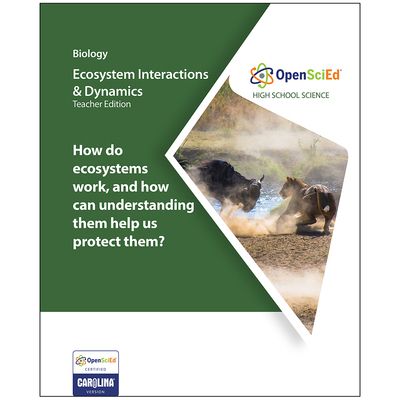Description
For additional program information and pricing, complete this form or contact your sales representative.
Biology. In Biology 1: Ecosystem Interactions & Dynamics, Carolina Certified Version*, students work to answer the Unit Driving Question: "How do ecosystems work, and how can understanding them help us protect them?"
This unit is anchored by students exploring the 30 by 30 initiative, which sets out to preserve 30% of US lands and waters by 2030. Students investigate human motivation for conservation and what that looks like in ecosystems around the US. They generate a number of questions about ecosystems and conservation and engage in deep investigation of the Serengeti ecosystem as a case study to help answer those questions.
In Lesson Set 1, students figure out that the creation of the Serengeti National Park was motivated by a desire to protect the great migration of wildebeest and other animals across the system. They analyze data and develop and use models to figure out how limiting factors affect wildebeest carrying capacity over time. In Lesson Set 2, student models become more complex as the students add populations and components and uncover mechanisms such as group behavior. They figure out how all the components interact as part of a complex system and how biodiversity can support ecosystem resilience. In Lesson Set 3, students consider the criteria humans use when making decisions about their interactions in the system and the impacts of their decisions. Students return to the US-based systems they investigated in Lesson 1 and apply what they figured out to evaluate the efficacy of conservation in the US. They use this evaluation to make recommendations about how humans can preserve additional lands and waters as part of the 30 by 30 initiative.
Throughout the unit students:
- Develop and use a model based on evidence to explain why wildebeest migrate.
- Use mathematics and computational thinking to explain how limiting factors such as food have impacted the wildebeest population over time, including carrying capacity.
- Use a model to generate evidence and develop algorithms to explain how group behavior explains interaction between wildebeest and their predators.
- Obtain and communicate information about other components of the system in a complex model that can be used to predict future outcomes.
- Evaluate the potential outcomes of a proposed road through the Serengeti ecosystem, including the criteria prioritized by different interest holders.
- Apply all the ecosystems and conservation ideas developed in the context of the Serengeti and evaluate conservation efforts in the US.
This 1-Class Unit Kit includes basic teacher access to instructional materials on CarolinaScienceOnline.com, plus the materials needed to teach 1 class of 32 students per day.
Building Toward NGSS Performance Expectations (PEs)
- HS-LS2-1: Use mathematical and/or computational representations to support explanations of factors that affect carrying capacity of ecosystems at different scales.
- HS-LS2-2: Use mathematical representations to support and revise explanations based on evidence about factors affecting biodiversity and populations in ecosystems of different scales.
- HS-LS2-6**: Evaluate the claims, evidence, and reasoning that the complex interactions in ecosystems maintain relatively consistent numbers and types of organisms in stable conditions, but changing conditions may result in a new ecosystem.
- HS-LS2-7**: Design, evaluate, and refine a solution for reducing the impacts of human activities on the environment and biodiversity.
- HS-LS2-8**: Evaluate the evidence for the role of group behavior on individual and species’ chances to survive and reproduce.
- HS-ESS3-3: Create a computational simulation to illustrate the relationships among management of natural resources, the sustainability of human populations, and biodiversity.
- HS-ETS1-3†: Evaluate a solution to a complex real-world problem based on prioritized criteria and trade-offs that account for a range of constraints, including cost, safety, reliability, and aesthetics as well as possible social, cultural, and environmental impacts.
†This performance expectation is developed across multiple courses.
Focal Science and Engineering Practices (SEPs)
- Developing and Using Models
- Using Mathematics and Computational Thinking
- Constructing Explanations
Focal Disciplinary Core Ideas (DCIs)
- LS2.A: Interdependent Relationships in Ecosystems
- LS2.C: Ecosystem Dynamics, Functioning, and Resilience
- LS2.D: Social Interactions and Group Behavior
- LS4.D: Biodiversity and Humans
- ESS3.C: Human Impacts on Earth Systems
- ETS1.B: Developing Possible Solutions
Focal Crosscutting Concepts
- Stability and Change
*All enhancements to materials and instruction for this Carolina Certified Version of the unit are approved by OpenSciEd to preserve the integrity of the storyline and the instructional model.
Specifications
- What’s Included:
-
- Unit Technology Pack (basic digital access to teacher's guide and all instructional resources for the teacher)
- Bags, Plastic, Resealable, 9 x 12"
- Bags, Resealable, Plastic, 6 x 9"
- Binder Clips, Small (3/4" W x 3/8" capacity)
- Card Set, Scavenger Hunt Images
- Card Sets, Event
- Card Sets, Interest Holder
- Card Sets, Regional Data
- Card Sets, Road Proposal
- Card Sets, Wildebeest Field Data
- Dice, Standard, Red and White
- Dry-Erase Marker Sets, Expo®
- Migration Maps
- Note Pads, Self-Adhesive, 5 x 8", Lined
- Note Pads, Self-Adhesive, Yellow, 3 x 3"
- Putty, Adhesive, 2 oz
- Serengeti Game Boards
- Serengeti Game Chips
- Serengeti Game Instructions
- Serengeti Maps
- Sets, Conservation Plan Storyboard
- Sets, Serengeti Article
- Top-Loading Sheet Protectors
- Whiteboards, Mini
expand to see full list - Return Policy:
-
If for any reason you are not satisfied with this item, it is eligible for a return, exchange, refund, or credit up to 180 days from date of purchase. Restrictions may apply. Returns & Exchanges Policy.
